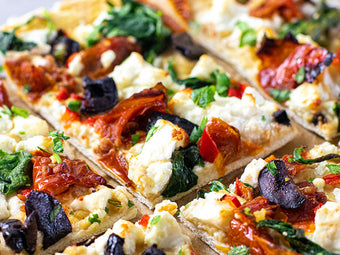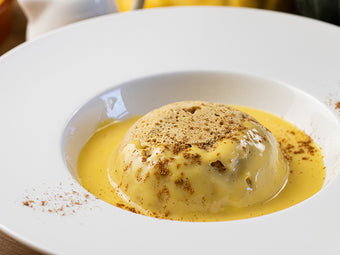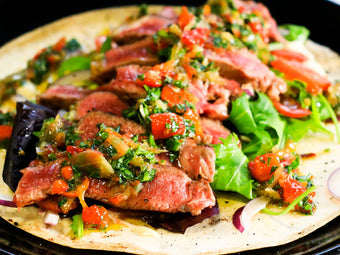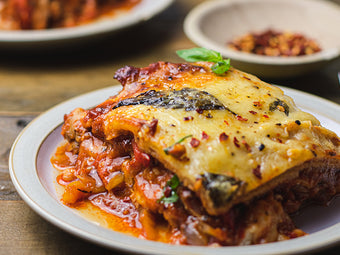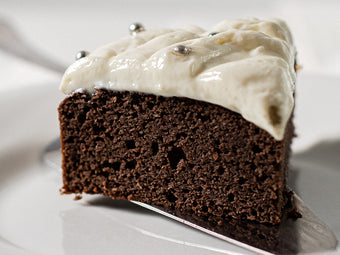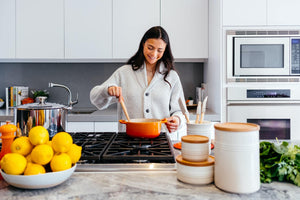What a nutritionist eats in a day
Check out Nutritionist, Gemma Shorter's low calorie, balanced lifestyle plan using Lo-Dough
Nutritionists spend their days advising people what to eat to lead a healthy lifestyle. It, therefore, made sense to us to take a peek into the food diary of Gemma, our nutritionist, to find out what she eats in a typical day. You might be surprised to learn that carbs are not the enemy and dessert is always on the menu! We have peppered this blog with plenty of meal/snack ideas that swap out high-carb, low-fibre starches for Lo-Dough, which is only 2.2g carbs and a massive 9.3g of fibre per piece...
If your perception of what a nutritionist eats are sticks of celery and chia seed puddings, then this may change your view. Just like everyone else, we lead hectic lifestyles and don’t always feel like cooking when we get home from a stressful day at work. Our job is to advocate the benefits of a balanced lifestyle, which means (as your mum once told you) if you eat your veggies, you can have dessert too.
Low cal, high fibre breakfast
Breakfast may not be the most important meal of the day, but it helps set you up for the busy day ahead. Believe it or not, what you eat for breakfast can influence your food choices throughout the rest of the day. A bowl of high sugar, low fibre, breakfast cereal will not keep you full for very long and can play havoc with your blood glucose levels – leaving you craving something sugary later in the day.
I’ll always start the day with a glass of water or a mint tea to help rehydrate myself after a night’s sleep. For breakfast, I go for something that I know will fill me up until lunch. If I’m going to be out the door early, I will make myself overnight oats the night before, otherwise I will opt for porridge or eggs in the morning.
Porridge is made from oats which are rich in fibre. Most of us in the UK do not eat enough fibre, consuming only 18g a day compared to the recommended 30g. We need fibre for healthy digestion and to feed the beneficial bacteria in our gut. Oats contain a soluble fibre called beta-glucan which also helps to lower cholesterol levels. I’ll stir a tablespoon of mixed seeds and pinch of cinnamon into my porridge. I like to mix up the toppings to keep it interesting. Examples include stewed frozen berries, apple, coconut, blueberries, crushed nuts and honey. If I’m feeling a little indulgent I will top my porridge with caramelised banana (gently fried with coconut oil, maple syrup and cinnamon), a square of 70% dark chocolate, almond butter and cacao nibs. I always try to include a portion of fruit with my porridge and then some protein or healthy fats to help slow down the release of the sugars into the bloodstream.
Eggs are meant to be the best breakfast for keeping you full until lunch because they are rich in protein. My favourite way to enjoy eggs is poached and served with sourdough bread, smashed avocado and chilli flakes or using up leftover veg to make an omelette. At the weekends, when I’ve got a little extra time, I like to make a shakshuka or a scrambled egg Lo-Dough burrito.
Healthy lunch
Lunch is a great opportunity to use up leftovers. If you cook more than you need for dinner, then you can take some for lunch the next day or throw some veg or meat into a salad. I know the word ‘salad’ makes you think you’re on a diet but salads are so versatile that you really can throw anything in them. The key to the perfect salad is making sure you include greens like spinach, kale or watercress, a carbohydrate base such as leftover sweet potato wedges or a grain like quinoa, vegetables like pepper, beetroot or sauerkraut (fermented cabbage which our gut bugs love), healthy fats from nuts, seeds or avocado, and a good dressing like extra virgin olive oil and lemon juice.
In the colder months, I make a soup at the weekends and freeze it in batches. I’ll add lots of veg, some beans and lentils to make the soup more filling, and jazz it up with spices and herbs. Most of us are guilty of eating the same foods every week. The key to a healthy gut is having a diverse range of gut microbes and this is achieved by eating lots of different plant foods. I try to mix up the vegetables, grains and legumes I eat every week which, as well as supporting gut health, also keeps meals interesting.
Low carb dinner
Dinner is where I like to get creative, however, it is understandable that long, busy days in the office can make cooking dinner feel like a chore. Plus, if I’ve gone straight to the gym after work I may not get home until 8pm. So, quick, easy and simple recipes that use lots of wholesome ingredients are my go-to when it comes to dinner.
Tray bakes are great as I can throw them in the oven and get on with something else. If I’m not in the mood to go the gym, then I can do a YouTube workout whilst my tray bake cooks in the oven. My favourite is salmon with red peppers, red onion and potato wedges, with a feta, olive and spinach salad.
In the winter, I love making stews and curries that will last me a couple of nights. There’s nothing better than coming home from work and only having to heat your dinner up. I try to stay away from refined grains like white bread, pasta and rice because they have been stripped of their nutrients and raise blood glucose levels quickly. If I’m going to make something like a pizza, pie or quiche then Lo-dough makes a great low-carbohydrate alternative that’s also high in fibre.
Low calorie snacks
There is always a debate about whether snacking is healthy or not. By mid-afternoon, we often feel low in energy and lack concentration because our blood glucose levels have dropped. Not eating anything between lunch and dinner (often 6-8 hours) is therefore unrealistic, especially if you are doing exercise after work.
Snacks should contain some protein and fibre, and not too much sugar. My go-to snacks are a handful of almonds, carrots/spelt crackers with houmous, an apple/medjool date with almond butter, homemade chocolate brownie energy balls and homemade wholemeal muffins.
I’m a huge chocolate fan so mid-afternoon or after dinner, I’ll have a few pieces of 70% dark chocolate (and I never feel guilty about it!).
Drinks
I don’t like the taste of tea or coffee, so my go-to drink is a glass of water. According to the National Diet and Nutrition Survey, only 8% of us are drinking the recommended 6-8 glasses (1.5 litres) of water per day, with a large percentage of us only drinking 1 glass a day (shocking!).
As well as water, I drink lots of herbal teas like mint, ginger and chai. If I fancy a fizzy, sweet drink then I’ll buy a bottle of kombucha which contains lots of friendly bacteria which our guts love. I don’t drink much alcohol so will usually only have a glass or two at the weekend.












